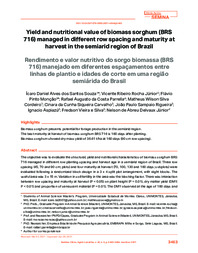Yield and nutritional value of biomass sorghum (BRS 716) managed in different row spacing and maturity at harvest in the semiarid region of Brazil.
Yield and nutritional value of biomass sorghum (BRS 716) managed in different row spacing and maturity at harvest in the semiarid region of Brazil.
Autoria: SOUZA, I. D. A. dos S.; ROCHA JÚNIOR, V. R.; MONÇÃO, F. P.; PARRELLA, R. A. da C.; CORDEIRO, M. W. S.; CARVALHO, C. da C. S.; RIGUEIRA, J. P. S.; ASPIAZÚ, I.; SILVA, F. V. e; DELVAUX JÚNIOR, N. de A. D.
Resumo: The objective was to evaluate the structural, yield and nutritional characteristics of biomass sorghum BRS 716 managed in different row planting spacing and harvest age in a semiarid region of Brazil. Three row spacing (45, 70 and 90 cm; plots) and four maturity at harvest (70, 100, 130 and 160 days; subplots) were evaluated following a randomized block design in a 3 x 4 split plot arrangement, with eight blocks. The useful area was 3 x 15 m. Variation in soil fertility in the area was the blocking factor. There was interaction between row spacing and maturity at harvest (P < 0.05) on plant height (P = 0.01), dry matter yield (DMY; P < 0.01) and proportion of senescent material (P = 0.01). The DMY observed at the age of 160 days and spacing of 90 cm was 41.40% higher than the DMY at the same age and in spacings of 45 and 70 cm (mean of 21.45 t/ha). As the maturity at harvest increased, there was a reduction in the crude protein content (P < 0.01), potential degradability (P < 0.01) and effective degradability (P < 0.01) of dry matter, and the content of non-fiber carbohydrates (P < 0.01), total digestible nutrients (P < 0.01) and the readily soluble fraction (P < 0.01) of the dry matter increased. Considering the yield and nutritional characteristics of biomass sorghum BRS 716 managed in the semiarid region for silage production, the row spacing of 90 cm and the maturity at harvest of 160 days after planting are recommended.
Ano de publicação: 2021
Tipo de publicação: Artigo de periódico
Unidade: Embrapa Milho e Sorgo
Palavras-chave: Biomassa, Cinética ruminal, Espaçamento, Matéria Seca, Plantio, Rendimento, Sorghum Bicolor
Observações
1 - Por padrão são exibidas publicações dos últimos 20 anos. Para encontrar publicações mais antigas, configure o filtro ano de publicação, colocando o ano a partir do qual você deseja encontrar publicações. O filtro está na coluna da esquerda na busca acima.
2 - Para ler algumas publicações da Embrapa (apenas as que estão em formato ePub), é necessário ter, no celular ou computador, um desses softwares gratuitos. Sistemas Android: Google Play Livros; IOS: iBooks; Windows e Linux: software Calibre.
Acesse outras publicações
Acesse a Base de Dados da Pesquisa Agropecuária (BDPA) para consultar o acervo completo das bibliotecas da Embrapa.

